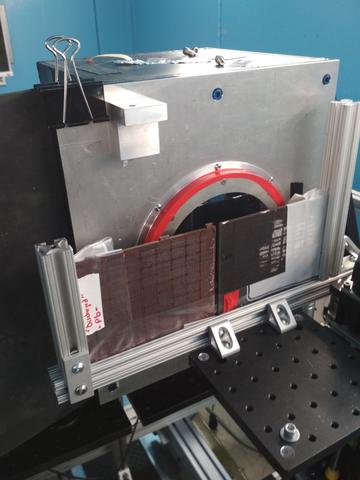Summary
To facilitate grid stabilization with variable energy sources such as solar and wind, battery energy storage is set to be one of the defining technologies of the century, with US capacity having grown from 4 MWh to over 20 GWh over a span of 14 years. Advanced lead batteries are a critical part of this landscape
Description

Figure 1. Photo of proof-of-concept measurements that showed neutron Bragg-Edge Imaging can detect the state of charge of commercial lead battery electrodes produced by Exide Technologies.
Scientists will be joining forces with NIST from INMA (Instituto de Nanociencia y Materiales de Aragón) and Exide Technologies, a global battery company through one of its R&D centers based near Madrid. They will study the fundamental processes that govern recharge efficiency and battery electrode failure using a suite of neutron beamline experiments.
Through a specific focus on battery electrodes, which transfer energy to and from the electrolyte in order to power the polarized device to which they connect, neutron imaging will be used to study the batteries in operation across different duty cycles. For energy storage applications, many of which incorporate renewable energy elements, advanced lead batteries operate at partial-state-of-charge and in high depth-of-discharge, both demanding duty cycles.
Neutron imaging is capable of not only mapping the activity of the surface of the electrodes but the entire electrode and electrolyte present in the battery. This provides a complete picture of how battery electrodes are changing at the micro-level, something never-before done in lead battery research. By describing the electrode phenomena that govern battery lifetime, the research is generating new information on how to control the active material and maximize battery life in all applications for advanced lead batteries.
Neutron imaging maps the state of charge by measuring the relative concentration of two crystal phases that correspond to either a discharge or charged state by using the Bragg edge imaging contrast. In Bragg scattering from a crystal, a lattice plane will no longer scatter a neutron when the neutron wavelength is twice the lattice spacing. By taking images at different wavelengths, one can measure the concentration of a given crystal phase, which will be used to map the state of charge of lead batteries.
Notice of Online Archive: This project ended in 2025 and thus this page is no longer being updated and remains online for informational and historical purposes only. The information is accurate as of 13 March 2025. For questions about page contents, please contact Dan Hussey.

